NOTEBOOK 15

Antonio Seguso, Archimede’ s father, at work in the furnace, photograph from 1894.
PRESENTATION
A COMMON IDEAL
The “air” of Tiffany and the “air” of Archimede.
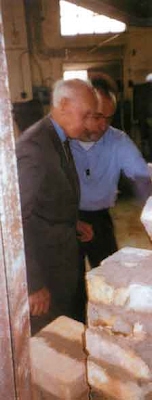
Archimede together with his grandson Antonio Seguso while building an oven.
What I’ve found does me the most good, is just to get into a taxi and go to Tiffany’s. It calms me down right away, the quietness and the superb atmosphere of it; nothing very bad could happen to you there. If I could find a real-life place to live in that made me feel like I do at Tiffany’s…” These are Audrey Hepburn’s words in the famous film “Breakfast at Tiffany’s”. Although she is not referring to Louis Comfort Tiffany’s shop, the comparison between the atmosphere of Tiffany’s and that of home is striking. One of the things that led to the collaboration between Tiffany’s and Archimede Seguso in 1950 was the fact that they both believed in the same ideal of simplicity and refinement.
This fifteenth issue of “I Quaderni di Archimede Seguso” celebrates this bond. lt is a significant one because both have always sought a way of expressing beauty that combines the ancient and the new: one that unites the entrancing values of colour and light with the subtle essentiality of form.
It is two years now since the death of Archimede Seguso, the great glassmaker who brought Murano glassware to its highest level of perfection. It was he who felt the “air” of home that provided the bond between his furnace and Tiffany’s. Now his grandson Antonio has become the “deus ex machina” of the Murano atelier. For years his grandfather guided his hand and forged his sensibility; and the collaboration with Tiffany’s and with its designers has continued. The pages that follow recount a few episodes, from the past and the present, of an enduring collaboration.

Vases and bowl of the “Reflections and Inlays” collection made for Tiffany, 1990
There is a chapter on the glass gardens, which kept alive a refined tradition that had its roots in the Renaissance, a tradition that symbolizes environmental harmony. There is another chapter on a revival of ancient practices in a contemporary key, a “modern way of thinking” that harks back to the past. There are other interesting items for the reader as well, such as the passage on the interpretation of ergonomic design, in its refinement and simplicity; or an evaluation of a typically Venetian form of production devoted to “Reflections and Inlays”: the fluidity of watery colour and the sinuous suppleness of the finest blown glass. The first issue of these “Quaderni di Archimede” declared that the publication was to serve as a mirror of the “culture in motion” that Archimede Seguso was pursuing at the time; and which he intended to pursue ever more zealously: it would thus provide a means of expression for a “committed artistic production”. This was in 1994. This commitment is becoming evermore sharply focused: loyalty to the great values of tradition and, at the same time, a keen eye on the new culture in ferment around us.
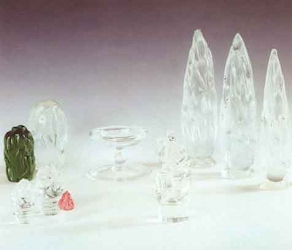
Several of the garden elements made in transparent and colored crystal, 1960.
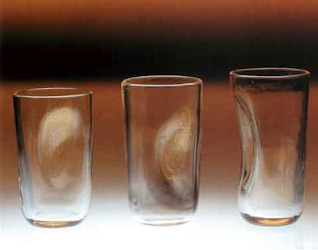
1997, “Gold Collection”, Elsa Peretti. The ergonometric hold characterizes the three crystal gold glasses of different heights.
The alliance with Tiffany’s has become a motive of pride for the firm of Archimede Seguso, and a spur for the future. The “air of Tiffany’s” and the “air of Venice” interpenetrate in an urge – increasingly felt by our society – towards an inspiriting idea of beauty amid the troubled world of today.
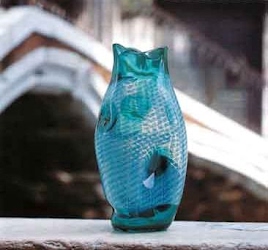
1990, Vase from the “Reflections and Inlays” collection made in collaboration with Tiffany. Vase, oval shape with irregular rim and green transparent crystal “eyes”.

1998, Archimede Seguso in the garden of his factory in Murano.
ATTUALITÀ CULTURALE
GARDENS OF GLASS
Fountains, columns, hedges, amphitheaters, trees, box shrubs.
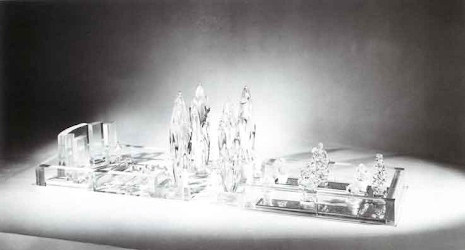
1960, from “Blue Book”. Majestic centerpiece representing a garden of transparent crystal with details in lattimo (white glass) divided in three parts: amphitheater, central oasis, and forum.
In antiquity, the garden was considered a “hortus conclusus”. A small place of intimate delights: a sort of Eden on a worldly scale. It was here that the wealthy, cultured souls of the time retired to bond with nature and to pass their daily leisure hours. Later, in the Renaissance age, gardens were adapted to suit the new forms of culture. It was the age of the Italian garden, mostly on the slopes of hills, with changing vistas according to the various levels. This was complemented by the French-style garden, based on geometrical forms, humanly orchestrated around the central nucleus of the chateau. In opposition to these was the English garden, which adapted itself to the natural conformation of the site, exploiting its trees and vegetation, as well as its rocks, in accordance with a romantic idea of “wild” nature. Over the centuries other types of garden arose, like the Japanese (in particular Zen) garden, which met with European favour more than the Islamic kind, which was dominated by the irrigation of water in a fabulous atmosphere.

1960, from “Blue Book”. Details of the glass garden: wings, stage,and auditorium of the amphitheater.
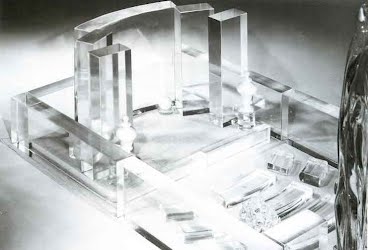
Florence, Garden of Boboli, details with hedges, flower beds, and central fountain.
Some splendid examples of the art of gardening still survive: Italy can boast the famous Boboli gardens in Florence and Tivoli near Rome, while France has the Vaux-Le-Vicompte, a masterpiece by Andre le Notre; numerous English gardens exist by such architects as Rent, Lancelot “Capability” Brown and Repton. Today in Kyoto one can stand in entranced meditation in the Zen gardens around the Golden Pavilion. Fifty years ago the Marchese Giovanbattista Giorgini, the inventor of the Florence fashion-shows, acted as trait-d’union between the Art Director of Tiffany’s, Van Day Truex, and Archimede Seguso. An encounter between two such great personalities could not fail to result in special creations. These were a series of prototypes and objects created for the enjoyment of the artists and for a select group of connoisseurs. Thus the old “trionfi da tavola” (majestic table ornaments) of the eighteenth century, made for royalty and aristocracy, became the pretext for the creation of major new masterpieces in glass for modern tables of equally refined taste.
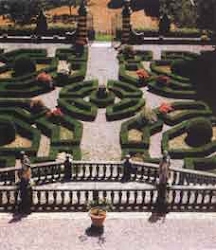
1960, from “Blue Book”. Garden formed from a green hedge, trees, and central fountain.
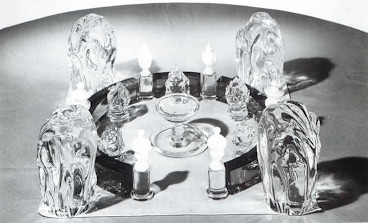
Above, typical Italian garden in Villa di Felceti in Pistoia, hedges,trees,and statues.
Archimede Seguso worked whole heartedly on the project, creating numerous tiny glass items to be assembled: fountains, columns, statues, bushes and boxwood hedges. Everything was laid out on a table, according to a predetermined design that privileged the harmony of formal concordances, of counterpoints, of chiasmi, of finely dovetailing forms. In one of these designs, the lay-out is divided into three parts: an amphitheatre, a relaxing oasis and a Roman forum. Each single piece, from the stage to the wings and the audience-area, is in handmade cut-glass; there is a special pleasure in spotting the tiny flaws that add to one’s appreciation of the workmanship: the hand of the artist and the craftsman at the same time. The plants and the statues of the ancient forum are all in solid Murano crystal. The tunics wrapped around the figures reveal a charming fluidity in the drapery and their attitude recalls that of the great Roman leaders; the artist involves us with an air of classicism. All the details are created in milk-glass: from the vases to the elegant amphorae.
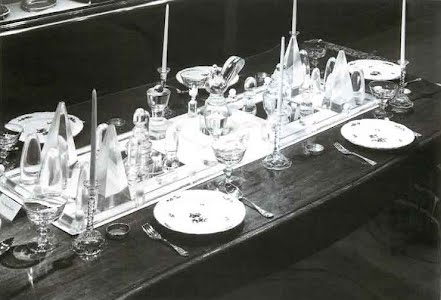
1960, from “Blue Book”. Pyramids and geometric shapes characterize this majestic centerpiece.
Another garden is entirely surrounded by a long hedge in green glass, bordered by trees pruned into bushes with a fountain in the centre. A third, composed of geometrical and pyramid shapes, evokes the land of the Pharaohs. And finally a “trionfo da tavola”, majestic centerpiece, with columns in zanfirico and encircled by surrounding walls in alexandrine, is adorned with spheres and jars in white glass, and recalls the agora. The miniature glassgardens are like a fantastic chess-board for the diners to feast their eyes on, gazing up the avenues and discovering new spaces revealed by the refraction of the light; the decorative elements all fuse in a single harmonious union: the magic of glass. These works are inspired by a line of aesthetics that comes to us in particular from the creations of the Venetian Settecento. The comparison is stimulating. Two or three centuries ago the prevailing taste hovered between the Baroque and the Rococò, favouring “whimsical” virtuosities and mannered elegance. These new gardens reveal a return to classical concepts: order, harmony, congruence among the separate parts and symmetry. A leap from nostalgia to futurity. Time passes: these gardens do not wither. Our eyes can still admire them, lingering over the table sumptuously adorned with its ornaments – and also with our dreams.
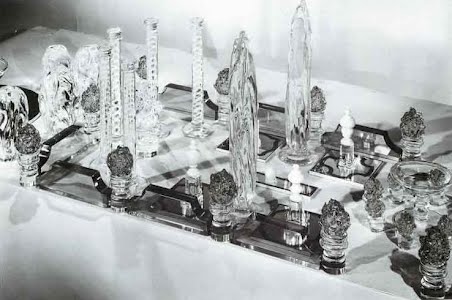
1960 from “BlueBook”. Garden composed of zanfirico columns and surrounding walls in alexandrite.
LOOK TO THE PAST
The magical combination Tiffany-Archimede: How to visit the antique in a modern way. With Lyn Tissot Creation-interpretation. This combination lies at the very heart of the concerns of art today. The emphasis is laid on the latter of the two terms. Tiffany, Charles Lyn Tissot, and the Venetian master of glasswork returned to the styles of the past, reviving them in an extraordinary fashion. And this is one of the most interesting – and culturally fascinating – aspects of recent production. In his artistic training, Archimede Seguso certainly had as models the items of glassware that appear in the paintings of Titian, Veronese and Tintoretto, great Venetian artists. These elaborate new works contain the pure lines of sixteenth-century glasswork, like the pieces in the painting, “The Feast in the House of Levi”. This provided the inspiration for vases, chandeliers and risers in the “Veronese manner”, whose elegant stems are joined to the base by means of glass globes of varying size. They are Renaissance forms completed by the rationalist purity of the twentieth century. They have now become cult objects for connoisseurs.

Candleholder and riser in “Veronese Style”, 1955. H. cm. 23, d. cm. 25; cm. 24.
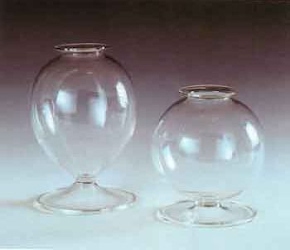
Vases, round shape, in transparent crystal in “Veronese Style”, 1983. H. cm. 31; h. cm. 23.
The same is true, for example, of the glass ice-buckets, which are a new version of the ones in “ice” glass of the late sixteenth century. The form is simple, without excessive treatment: the novelty consists in the addition of thin bands of glass placed horizontally at the base and at the opening of the bucket itself. Once again the ancient model is “reinterpreted”, without forcing the beauty of the archetype. Old glassware provides the inspiration for a series of delightful candlesticks in the form of small trees with baskets. The original model of the seventeenth/eighteenth century is displayed in the Glass Museum of Murano. The form is baroque and elaborate, accentuated by the hanging baskets with phytomorphic allusiveness.

Ice buckets with ribbing, baroque style, in transparent glass, 1961. H. cm. 15,5, d. cm. 19,5; h.cm. 14, d. cm. 18.
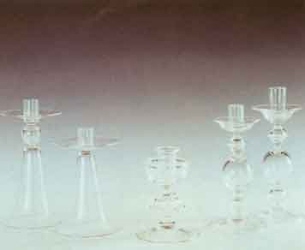
Group of candleholders in different styles and heights, “Veronese Style”, 1954, ’55, ’85.
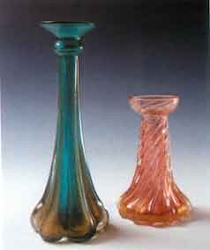
Art Nouveau style candlesticks in forest green and ruby splashed gold, straight and twisted ribbed, 1997. H. cm. 26; h. cm. 17.
The Archimede/Tiffany tree, from a formal point of view, is simplified and has greater purity of lines. With Louis Comfort Tiffany, other examples are small vases – candleholders in Liberty style: ruby and forest green colored, sprayed with gold, these recall the hues of some mosaic glazings conceived by Louis Comfort Tiffany. The elongated shapes are stems of Art Nouveau flowers, light and essential. Iridescent Things were different earlier in the century. In the thirties and forties, when the “Novecento” style came into its own, with its massive forms in homage to the Roman Empire, the young Archimede had created heavy sculptures in solid, iridescent glass, which recalled the fashionable sculpture of the day (for example Arturo Martini).

Figure, Camera, the boxer, in transparent, iridescent solid glass, 1934. H. cm. 41.
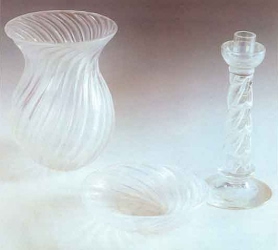
Vase, bowl and candleholder, with spiraling ribbing, in a light color and iridescent shine, 1998, (a revisiting of the style of the ‘Thirties).

In the center, Vase in transparent crystal, “Veronese Style”, 1983.
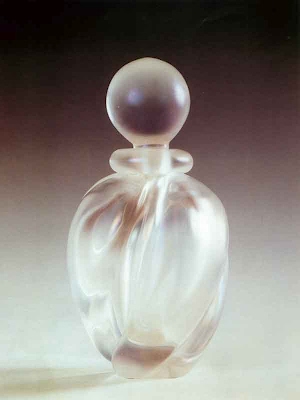
Perfume bottle, in a clear colored glass and iridescent shine, 1998, (revisiting of the style of the ‘Thirties). H. cm. 28.
Carnival and diversion are brought to life in this search for the placement of colours as well as forms, thereby overcoming neuroses and freeing the soul in its desire for flight. Today All of this confirms that Archimede was always an “innovator, although in continuity”. He possessed the essential qualities of one who interprets, profoundly and from the standpoint of his own time, the archetypical forms of the past.

Vases “Carnevale” , ruby and cobalt colored with crystal “eyes” and an elliptical ribbon in green and outlined in ametyst, 1989. H. cm. 24,30.

Vases “Carnevale” in cobalt blue, green and ruby glass with crystal “eyes”, 1989. H. cm. 32 and h. cm. 23.
For the last eight years, Antonio Seguso has been carrying on this aesthetic and cultural project, along the path laid down by his grandfather, as part of the fruitful collaboration with Tiffany. His task is one of great responsibility and satisfaction.

Ice Bucket, “Carnevale” in cobalt blue and ruby red with lateral ring shaped handles, 1989, (revisiting of the piece made in crystal in 1967 ). H. cm. 20, d. cm. 26.
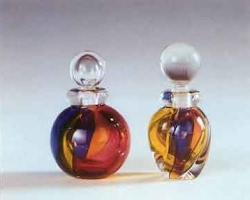
Perfume bottles, “Carnevale” with colors varying from ruby to blue to yellow; rounded or with ribbing, 1987. H. cm. 12 and h. cm. 13,5.
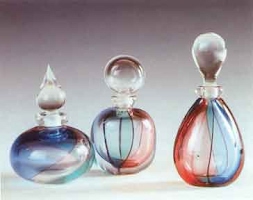
Perfume bottles “Carnevale”, decorated with longitudinal bands of ruby, green and blue glass separated by ametyst threads, 1989. H.cm. YJ.h.cm. 18,21.
The generational change inevitably brings other changes along with it, but what remains constant is the desire to maintain, as an unquestionable and inalienable resource, the family tradition and all that remains of the six or seven-hundred years’ work of a long line of glas-smakers. Innovations, like artistic creations, must be weighed in the balance and must correspond to certain fixed rules, because they have to fit into a certain context – that of the Seguso atelier, whose aesthetic traits are clearly visible and known to the whole world.
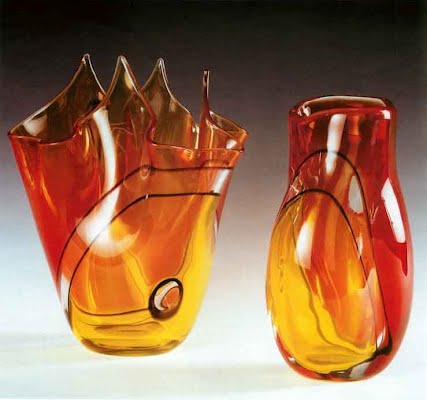
Vase “Carnevale”, 1998, interpretation of the traditional “handkerchief” vase of 1952 and oval shaped Vase, solar “Carnevale”, 1998. H. cm. 30,28; h. cm. 30,28.
When an unsigned work is immediately recognised and imitated, it means that it has begun to be universal and has entered the canons of the Aristotelian conception of art.

Antonio Seguso’s new production: pair of opaque orange and black vases with filigree decorations and red and white design, 2001. H. cm. 25,5 and h. cm.14.
SUGGESTIONS FOR TODAY
ELEGANCE AND ERGONOMICS
A simple glass can reflect both functionality and elegance: it is the happy result of an ergonomic design.

1997 “Gold Collection, Elsa Peretti. Plate glass goldergonomic shape.

Ergonomic decanter, sweets platter and bowl, 1980. Design Elsa Peretti, made by Archimede Seguso exclusively for Tiffany &Co. H. cm. 30, d. cm. 28; d. cm. 28.
Tasting a good wine in a beautiful vessel is essential. Drinking from a kylix or from a rhyton, for the ancient Greeks, was like performing a ritual. The elegance of the glass was not an end in itself: it had to suit the hand, the gestures of raising and offering, and the pleasure of the sampling. Today, ergonomic design is at the basis of all significant table-furnishings. Elsa Peretti was fully aware of this when she designed, first with Archimede Seguso and then with his grandson Antonio, a stupendous series of household objects and items.
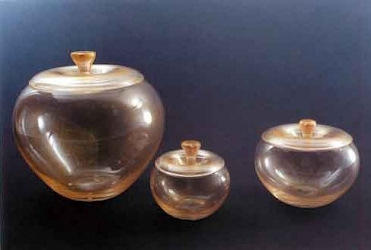
“Gold Collection”, Elsa Peretti, 1997. In alto, Scatole a forma di mela. H.cm. 12, h. 17,h.24.

“Gold Collection”, Elsa Peretti, 1997. Group of three bell-shaped vases with re-entrant base in crystal gold glass. H. cm. 21, h. cm. 30, h. 36 cm.
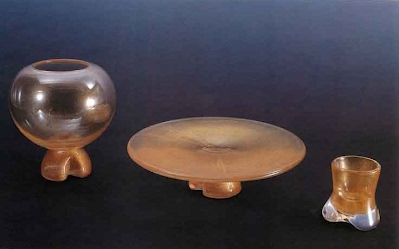
“Gold Collection”, Elsa Peretti, 1997. Candleholder, sweets platter and round vase with bone shaped pedestal. H. cm. 7, d. cm. 28 and h. cm. 28.
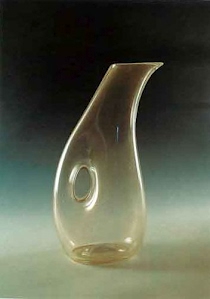
Object which distingues and underlines the elegance of the “Gold” collection. Decanter with ergonomic handle, slightly pressed laterally and arched contour;
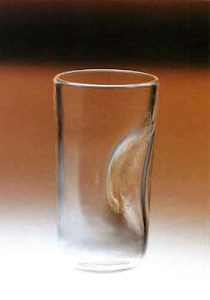
“Gold Collection” Elsa Peretti, 1997. Single glass in gold crystal with ergonomic design.
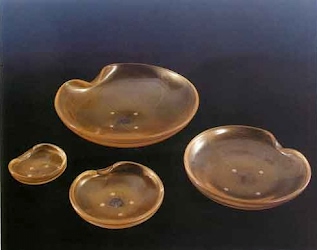
“Gold Collection”, Elsa Peretti, 1997. Above, a series of four bowls in gold crystal with ergonomic shape.
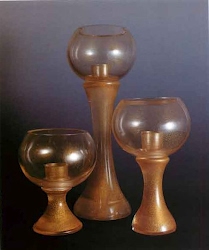
“Gold Collection” Elsa Peretti, 1997. Candelholders “Hurricane”.

“Gold Collection”, Elsa Peretti, 1997. Plate with linear form in gold crystal. D. cm. 40.

“Gold Collection” Elsa Peretti, 1997. Bowl, slightly pressed on the sides which allows easy grasp. H. cm. 25.
Anyone who has held in their hand one of the glass objects forged in the Archimede Seguso atelier has had the impression of an extraordinary interaction of the sense of touch with the material. The ergonomic form makes for a comfortable grasp and for efficient use. Two thousand years ago, the furnaces of Syria and Palestine produced similar artefacts: simple cylinders of a slightly flattened shape, with a slight groove for the handgrip. They were in blown glass of a light-green colour. Today, with a similar conception, a series of tableware is proposed which is both ancient and new, refined and comfortable.
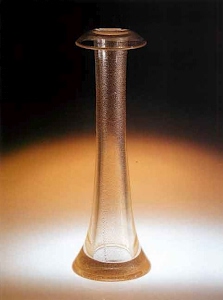
“Gold Collection” Elsa Peretti, 1997. Vase with elongated shape in gold crystal. H. cm. 20.
In the sixteenth and seventeenth centuries royal tableware consisted of gold objects; later in patrician houses, silver became fashionable. Plates, cutlery and mugs all had to flaunt their costliness. Today the most authentically aristocratic culture tends increasingly to combine wealth with simplicity, as with the “thumbprint dish” by Elsa Peretti, completed in the crystal and gold of Antonio Seguso. The “flat” decanter is one of the most perfect objects ever produced by the art of glass-making, with plates and table-mats, a salad-bowl with undulating rim, vases and the equally famous gilded starfish which gives a touch of originality and class to the sumptuously laid table. Naturally it is taste, the authentic fragrance of culture, which dominates.

“Gold Collection” Elsa Peretti, 1997. One of Elsa Peretti’s favorite objects: the starfish in gold crystal. H. cm. 23,5.
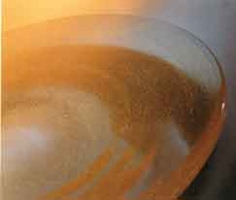
“Gold Collection” Elsa Peretti, 1997. Details of the platter/charger in gold crystal.
AND IT IS ALREADY HISTORY
“Reflections and Inlays”: an exquisite game of shapes and colors designed for Tiffany by the genius of Archimede.

“Reflections and Inlays” Collection, 1990. Vases and bowl with irregular rims, green colored with white inlays. H. cm. 41; h. cm. 14; d. cm. 29.
One’s first impression is that of an extraordinary marriage between the ancient wisdom of the artist and nature. Indeed, in the series of “Reflections and Inlays” created in 1990, we almost sense the water of the origins of Venice, with blues blending into greens, filigrees that seem to stir like subtle waves and an overall transparency that deprives the vases and goblets of all substantiality. Archimede Seguso always expressed himself through glass, right from the early years of the twentieth century, almost by predestination, from some inner need. He always had glass in his blood.
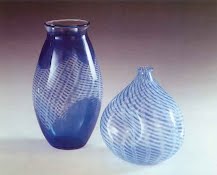
“Reflections and Inlays” Collection, 1990. Vases with white inlays on white “lattimo” glass and cobalt blue interruptions. H. cm. 33, h. cm. 24.
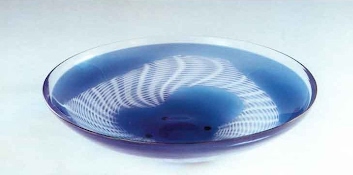
“Reflections and Inlays” Collection, 1990. Plate made in collaboration with Tiffany, cobalt blue. H. cm. 10, d. cm. 42.
From his childhood we imagine him in a corner of the furnace observing his father at work on his bench, the red light of the fire illuminating his keen, attentive face. Then, when he himself began to work on the bench, even for eighteen hours a day, his imagination took possession of the liquid, incandescent material gleaming before his eyes. He studied, experimented, tried and tried again: he became an inventor of new techniques, acquiring superb virtuoso skills. Thus his vitreous pastes came into being, his murrine glasses, his canes, zanfirici and filigrees; then the lacework, the feathers, the compositions in lattimo (white glass), the lozenges. The glass gradually dematerialized, melting into the air.

“Reflections and Inlays” Collection, 1990, made in collaboration with Tiffany. Vases with irregular green bands and white inlays. H. cm. 38, h. cm. 26, h. cm. 27.
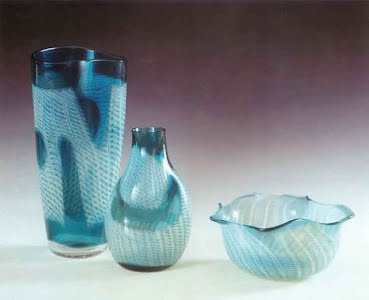
“Riflessi e Intarsi”, 1990. Vases made in collaboration with Tiffany, with cobalt blue decorations. H. cm. 32, h. cm. 28; h. cm. 33
The “Reflections and Inlays”, created at the venerable age of eighty-one, are some of the most beautiful objects to have emerged from the Murano furnaces. They are highly distinctive sculptured vases, in which the simplicity of the forms is combined with a resounding taste in colour, applied with brushstrokes that accentuate the movements of the delicate blown glass. The undulating rims, tenuously and ethereally transparent, complete the vase, together with “eyes” that allow us to “enter” the object through coloured spaces. They are now objects of extreme rarity: only seven articles were created, each one carefully numbered and signed. Moreover, they are all unique since they were created individually, each one presenting slight variations in the workmanship.
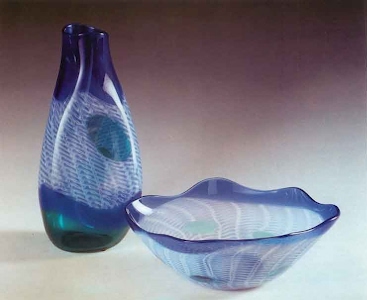
“Reflections and Inlays”, 1990. Vase and bowl made in collaboration with Tiffany, decorated in cobalt blue with green “eyes”. H. cm. 35; h. cm. 32.
1989 AT NEW YORK
Those giant candlesticks, a symbol of an interpenetration between history and current events.
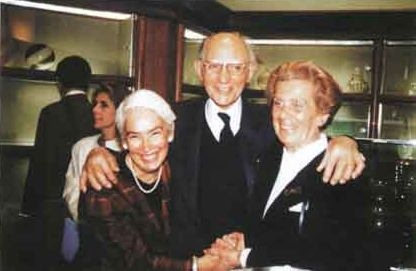
Archimede Seguso standing between his wife and Liz Franceschini at the inauguration of his personal exhibit at Tiffany on Fifth Avenue in New York, 1989.
There have been many fruitful moments of collaboration between Tiffany and Archimede Seguso, but now we wish to recall one event in particular: the dinner organised on Fifth Avenue in New York to celebrate Archimede Seguso’s eighty-first birthday, April 25th,1989.

Archimede Seguso between his grandson Antonio and his brother Angelo, in the furnace, while being toasted in honor of his 88th birthday. December 17, 1997.
With the glittering showcases of jewels and the finely laid tables, the atmosphere of the feast was illuminated by the light of the giant candlesticks designed by John Loring, ten years earlier, and created by Archimede himself. On this occasion, these candlesticks became the symbol of the relationship between the famous New York firm and the glorious Murano glassworks. Tall, solemn, even majestic, but at the same time elegant in their neo-classical structure, the candlesticks struck everyone as expressing the encounter between the refined designs of Tiffany’s and the skillful craftsmanship of Archimede. The ancient had become modern; and viceversa. In fact, Archimede’s birthday was on December, 17th, but it had been decided to make the celebration coincide with the ancient feastday of the Venetian Republic; the mayor was present and we also received the backing of the Save Venice organisation, since monuments and the environment are not the only treasures that need preserving: there are also men – in particular, the master craftsmen in their workshops. For this reason a retrospective exhibition had been organised of fifty works by Archimede, covering a period of forty years of success. Being modern means being aware of a great historical heritage that we must turn to as a stimulus for each new creation. One of the fundamental characteristics of both Tiffany’s and Archimede Seguso has always been – and still is – the fusion of history and contemporaneity. A handshake between Archimede Seguso and John Loring sealed the sumptuous dinner, renewing a commitment to this fruitful collaboration; after the death of Archimede, this commitment has been taken up by his grandson Antonio.
History, in fact, is still being made.
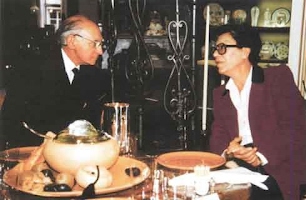
New York, April 25, 1989, holiday of San Marco. Archimede Seguso with Elsa Peretti during a dinner set up in honor of his eighty-first birthday.

Archimede and Gino Seguso with John Loring and Liz Franceschini in the furnace in Murano during a recent visit, 1994.
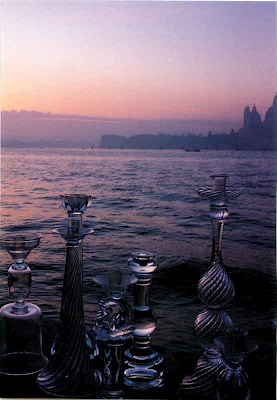
A collection of candleholders designed by John Loring and made by Archimede Seguso.
